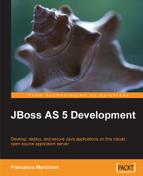In this book, you will find a number of styles of text that distinguish between different kinds of information. Here are some examples of these styles, and an explanation of their meaning.
Code words in text are shown as follows: "Since release 5.1.0 of the application server, the admin console is bundled as a web application in the deploy folder of JBoss AS."
A block of code will be set as follows:
<mbean code="org.jboss.util.threadpool.BasicThreadPool" name="jboss.system:service=ThreadPool"> <attribute name="Name">JBoss System Threads</attribute> <attribute name="ThreadGroupName">System Threads</attribute> <attribute name="KeepAliveTime">60000</attribute> <attribute name="MaximumPoolSize">10</attribute>
When we wish to draw your attention to a particular part of a code block, the relevant lines or items will be shown in bold sometimes with numbers in square brackets referring to notes in the text:
<attribute name="Log4jQuietMode">true</attribute> <attribute name="RefreshPeriod">60</attribute> [1] <attribute name="DefaultJBossServerLogThreshold">DEBUG</attribute> </mbean>
Any command-line input or output is written as follows:
twiddle -s localhost invoke "jboss.system:type=ServerInfo" listThreadCpuUtilization > threadCpu.txt
New terms and important words are shown in bold. Words that you see on the screen, in menus or dialog boxes for example, appear in our text like this: "In the left frame expand the Resources | Datasources leaf and choose the suitable transaction option."
Note
Tips and tricks appear like this.
